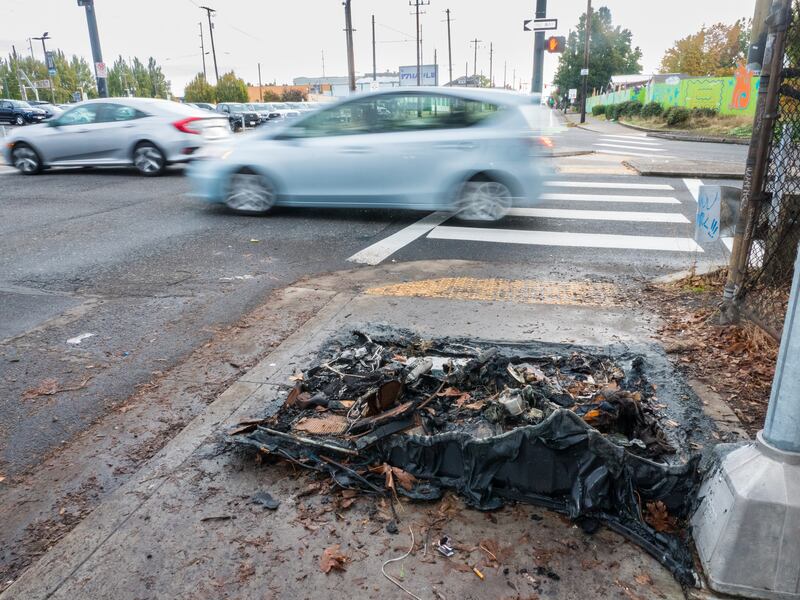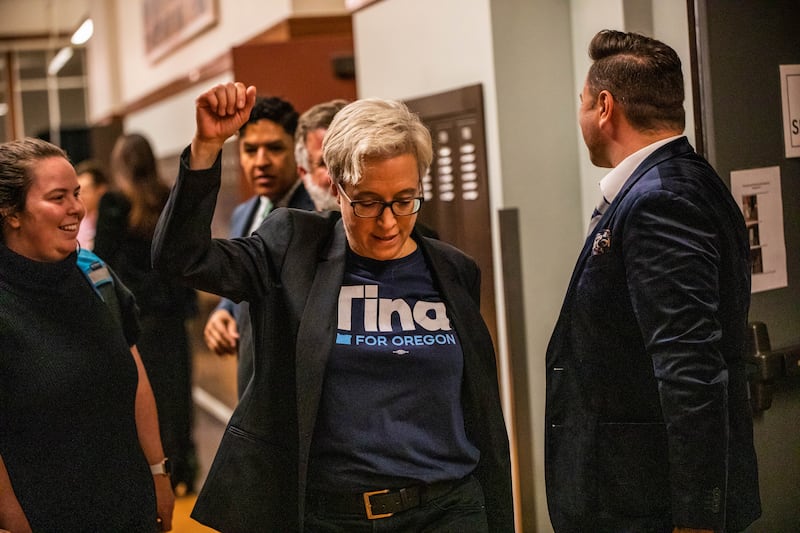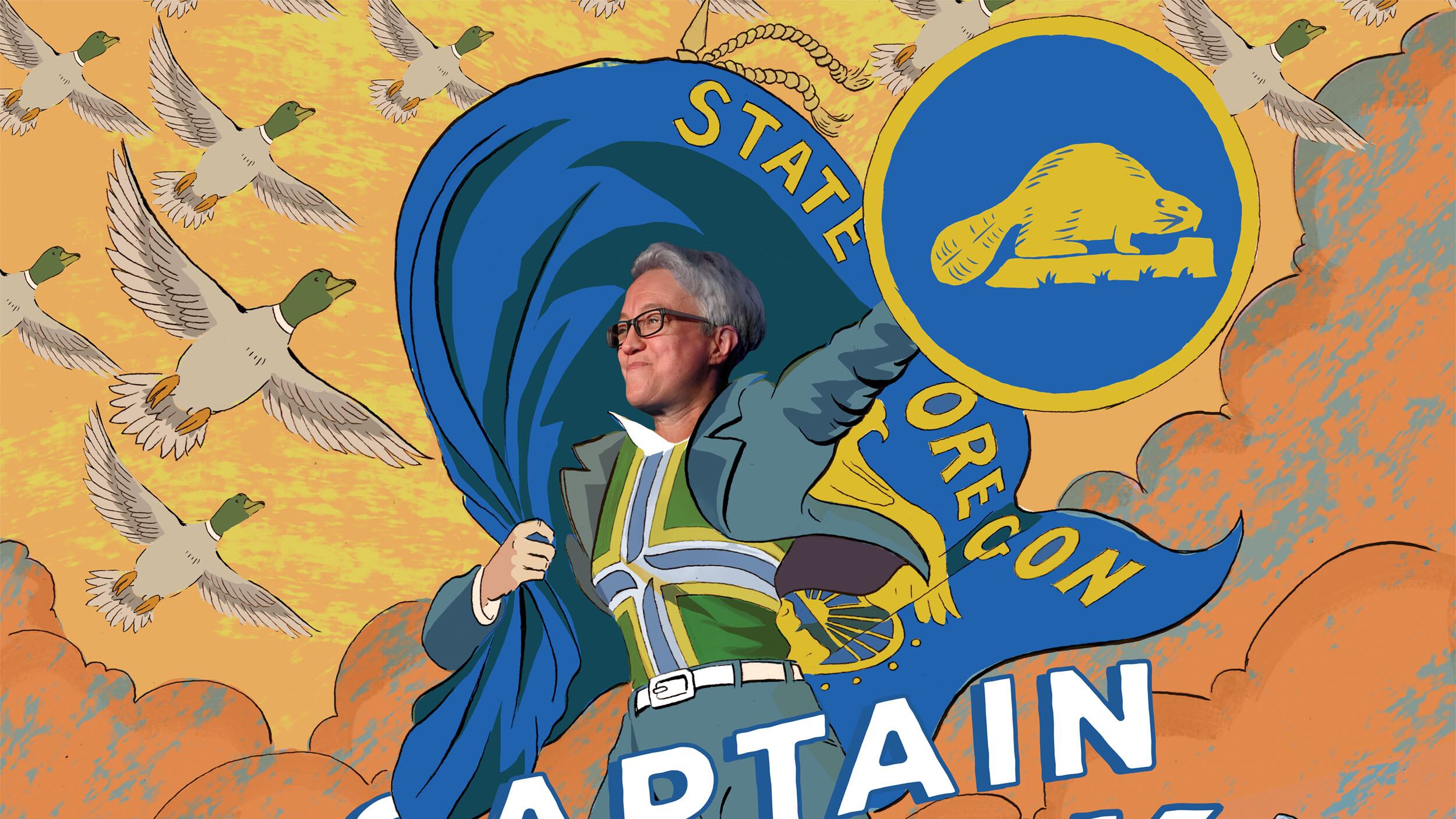Governor-elect Tina Kotek loves Marvel movies. Now, after a bruising election, Oregonians need her to become a superhero.
She must make that transformation as soon as Jan. 9, when she’ll be sworn in as the 39th governor in the state’s history and join Massachusetts Gov. Maura Healey as one of the nation’s first two openly lesbian governors.
Few of Kotek’s predecessors have inherited a bigger mess or done so with less of a public mandate.
Oregon’s rate of unsheltered homelessness is among the nation’s highest. Oregon is near the bottom in access to mental health and addiction services. Our high school graduation rate ranks among the nation’s lowest. Our largest private employer, Intel, is having financial woes and developing a wandering eye.
The state’s largest city is a national punching bag—the “City of Roaches,” one of Kotek’s opponents, the unaffiliated candidate Betsy Johnson, termed it.
In an October interview with WW, Johnson provided a more detailed assessment of Oregon’s ills.
“Our streets are awash in drugs and crime and violence. Our schools are graduating kids who can’t read,” Johnson said. “Eighteen percent of the state thinks we’re doing OK. The rest think we’re off track. We’ve got eight counties who’ve actually voted to leave the Oregon family.”
Kotek, 56, bested Johnson and Republican Christine Drazan last week for the prize of leading a troubled state. She did so with only 47.1% of the vote, the smallest share for a victorious candidate since Barbara Roberts won with 45.7% in 1990.
While the second- and third-place finishers now get to enjoy vacations, Kotek must immediately set to work hiring staff, formulating a multibillion-dollar budget, and figuring out how to avoid the fate of her predecessor, Gov. Kate Brown, who ends her tenure as the nation’s least popular governor.
In some ways, Kotek is the night relief captain on the Titanic.
As the race tightened in the final weeks, Kotek became more specific about her blueprint for tackling Oregon’s woes. She identified five areas for immediate focus. Here’s her initial to-do list, along with what Salem observers say about her prospects.

She says she’ll clean up the streets and attack Oregon’s housing crisis.
Polling has shown that the related issues of homelessness and a housing shortage are top concerns for Oregon voters. Whether Kotek can make material progress in those areas will determine her success.
The enduring image from the political ads that all three candidates produced is the squalor of Portland’s unsanctioned camps.
“I called for a homelessness state of emergency three years ago, while Kate Brown did nothing,” Kotek said in one campaign ad. “We don’t need a red state takeover to clean up the damn trash.”
When she takes office in January, Kotek plans to finally declare that homelessness state of emergency.
Kotek has been in touch with the mayors of the state’s largest cities about strategies for deploying more outreach teams, connecting people eligible for benefits (such as veterans) with resources, and expanding managed shelters. Portland Mayor Ted Wheeler briefed Kotek before announcing his plan for ramping up housing and building large new camps.
“Gov.-elect Kotek was receptive to the plan and will meet with my team and I again this week in person to discuss opportunities for continued partnership,” Wheeler said.
She’s laid out some specific targets: By 2025, she’ll “end unsheltered homelessness for veterans, families with children, unaccompanied young adults, and people 65 years and older.”
Jimmy Jones, executive director of the Mid-Willamette Valley Community Action Agency in Salem, says Kotek is proposing strategies that should soon make a difference. Rather than spending heavily on keeping housed people in place as the state has done, Jones says, Kotek’s plan aims to move the most vulnerable people on the streets inside.
“For the public to have confidence, they are going to have to see a visible difference in the number of people outside and the amount of trash on the streets,” Jones says.
Kotek also says Oregon will build enough housing by 2033 to get everyone living outdoors under a roof. (That’s 10,139 people as of 2019. The numbers for 2022 are not yet available.)
The most direct tool Kotek will have at her disposal is the Oregon Department of Housing and Community Services, which funds affordable housing through tax credits.
Critics say the agency moves slowly, has failed to adapt to Oregon’s housing crisis and, lately, has been overwhelmed by the task of allocating federal bailout dollars. Kotek wants the agency to aggressively speed the production of affordable housing and find ways to promote development of all types of housing.
Margaret Van Vliet, a former director of housing for both the city of Portland and the state, says Kotek could push Oregon Housing and Community Services, the state agency most involved in housing, to be both more creative and more aggressive.
“Other states provide more kinds of housing incentives,” Van Vliet says. She says Kotek could push lawmakers to expand the kinds of housing eligible for subsidy to include modular and manufactured housing.
Ed Blackburn, retired executive director of Central City Concern, which developed more than 1,000 units of affordable housing on his watch, says Kotek could also use the state’s control of low-income tax credits to demand Portland expedite permitting and design review, which are impediments to development.
“She could say, ‘We want to see more for our money,’” Blackburn says.

She says she’ll expand access to mental health and addiction treatment services.
In an October interview with WW, Kotek made a specific promise about the director of the Oregon Health Authority, Pat Allen, and the leader of its behavioral health division, Steve Allen (no relation).
“There won’t be any Allens there anymore,” Kotek said of OHA.
The reason: She’s fed up with the state’s response to untreated mental illness and substance use disorder.
The Oregon State Hospital is at the center of overlapping mental health crises. It lacks capacity for both patients who have been charged with a crime and are unable to aid and assist in their own defense and for a separate population of patients who have been civilly committed but for whom there are no beds inside hospitals or in secure community facilities.
Last year, lawmakers led by Kotek appropriated half a billion dollars of new funding for mental health services. Another $300 million will flow over the next two years to addiction treatment from Measure 110, which decriminalized many drugs and diverted recreational cannabis tax revenues to new services.
Kotek says patients and all Oregonians deserve to see better results from their tax dollars.
“We’re not providing enough access to care,” Kotek said in an interview with WW. And it’s not all about the money. “This is about how we have set up our system delivery.”
In the past, advocates say, Oregon has failed to make mental health and addiction services part of basic medical care—instead providing a patchwork of uncoordinated services and failing to serve the neediest, most obvious cases.
“The biggest issue is the meth addict screaming at the sky on the corner of César Chávez and Hawthorne,” says Kevin Fitts of the Oregon Mental Health Consumers Association. “If we don’t make progress with that population, the rest of it is just a jobs program.”
Fitts says OHA and elected officials spend too much time listening to the “big box” nonprofits who deliver services, and not enough time listening to patients to figure out what they need and what works.
Advocates think a Kotek administration is poised to make big gains in mental health and addiction treatment because the new money that will flow over the next two years is enough to make a difference—but only if it’s spent efficiently.
“All this spending needs to be coordinated,” Blackburn says. “We need a continuum of treatment so when somebody comes out of rehab, there is someplace for them to go.”

She says she’ll get big money out of Oregon politics.
The spending in the 2022 governor’s race went beyond staggering. Kotek spent about $29.5 million. The “anybody but Kotek” contingent spent another $40 million on Johnson and Drazan, including $5.75 million from Nike co-founder Phil Knight. (Oregon is one of just five states that places no limits on political contributions in state races.)
Despite winning the money chase and the election, Kotek insists she supports campaign contribution limits. One of the state’s leading proponents of such limits, Portland lawyer Jason Kafoury of Honest Elections Oregon, says he believes Kotek’s interest is genuine.
That’s in part because the limits Kafoury’s group proposes favor Democrats.
Honest Elections wants lawmakers to limit individual contributions in state races to $2,000 per donor—that would put Knight and many of the six-figure contributors to Johnson and Drazan out of the game.
Kafoury says Kotek is supportive. It helps that Honest Elections’ plan includes small-donor committees, preserving the power of unions, a vital source of support for Democrats and the biggest donors to Kotek’s campaign.
If lawmakers fail to pass such a law next year, Kafoury says, he’s confident voters will approve such limits in an Honest Elections ballot measure in 2024.

She says she’ll narrow the state’s urban-rural divide.
Kotek promised in declaring victory that she would be “a governor for all Oregonians.”
“I will work to bridge the divisions in our state,” she said in a Nov. 10 speech declaring victory. “I’ll spend time in communities all over Oregon working to fix problems and partner with Oregonians who want to find solutions.”
She faces long odds. Kotek won in just seven of Oregon’s 36 counties. And in most of the counties in which she lost, Drazan won overwhelmingly. And over the past two decades, the red counties have gotten much redder and the blue far bluer.
Reversing that trend won’t be easy. “Is there a more ill-suited person to help rural Oregon than Tina Kotek?” DHM Research pollster John Horvick asks. “I don’t know her personally, but she is very much identified with Portland and the Democratic political establishment. It’s going to be hard to walk into Burns and be that person.”
Two veteran Republican lawmakers say that if Kotek shows up in rural communities and pushes lawmakers and state agencies to address housing, homelessness and economic opportunity, she can win friends.
“She has the ability to get a lot done,” says state Sen. Lynn Findley (R-Vale). “Homelessness and housing aren’t just a Portland problem. A lot of Eastern Oregon has significant homeless issues and, on a per capita basis, maybe it’s worse out here.”
Rep. Werner Reschke (R-Malin) says he took Kotek in 2018 to visit Klamath Works, a nonprofit that helps people leaving incarceration and rehab to develop skills. The organization refurbishes bicycles but did not have enough. Kotek sent a load of bikes down from Portland.
Reschke says the opportunity exists for her to do that again on a much larger scale. “People down here feel like we’re forgotten. This is a chance to start anew and start afresh,” Reschke says. “I hope both sides will take advantage of that.”

She says she will get tough on state bureaucrats.
During her campaign, Kotek was unsparing in her criticism of Gov. Brown, her fellow Democrat, and state agencies.
“I’m frankly tired of things not working,” Kotek told WW in an interview during the campaign. “Things have not functioned the way they are supposed to function.”
She points the finger at Brown and directors of many of the state agencies who report to the governor, rather than rank-and-file employees.
“I put the responsibility on the managers and leadership,” Kotek told WW. “What I want to see from agency leadership as the next governor is that we have people who have a plan, have a timeline, and know how to get it done.”
Political director Joe Baessler of American Federation of State, County and Municipal Employees Council 75, whose union has 33,000 Oregon members, many of them state employees, points out that the state’s agencies and nearly 300 boards and commissions report directly to the governor. In practice, that means agency directors communicate with policy advisers in the governor’s office.
“State agencies need a firm vision,” Baessler says. “The way the governor’s office works with policy advisers doesn’t work very well. They are just a conduit for information and don’t have enough authority.”
Kotek’s biggest test of her willingness to hold state agencies and public employees accountable is likely to come in K-12 education, where graduation rates and test scores have riled a powerful constituency—parents. And businesses paying for the Student Success Act, a 2019 tax on corporations that brings in more than $1 billion a year for schools, want to see improvement.
Kotek criticized Brown for vaccinating teachers first without reopening schools and called current test scores “unacceptable.” So while she’s unquestionably going to remain union-friendly, there are reasons to believe she’ll demand accountability.
“We’re going to give you tools to do your job better,” she told WW, referring to public employees. “And we also need to see outcomes. I’m OK with those hard conversations.”
Kotek says the Student Success Act and robust revenue from income taxes mean state agencies are no longer working from a position of scarcity. Now, she says, it’s fair for Oregonians to expect better results for taxpayer dollars.
Much of what Tina Kotek proposes to do as governor could be lumped together as a pledge to spend taxpayer dollars more effectively.
That’s an important goal. She’s been less vocal about how to grow the economy or even preserve the flow of tax dollars that fund services. In Oregon, one of few states with no sales tax, that means cultivating and retaining the private-sector employers whose workers pay income taxes.
Kotek’s economic development platform is modest. It doesn’t offer any vision for how she would help employers grow or give any evidence she’s thought about the retention and growth of existing Oregon employers.
But some business leaders who know her think Kotek can work effectively with the business community.
“She got elected without really any business support,” says Peter Bragdon, executive vice president at Columbia Sportswear and former chief of staff to Gov. Ted Kulongoski. Yet he sees potential. “She is enough of a deal-maker to have a real ability to surprise people by making things happen.”
“She will listen to your concerns,” says Julia Brim Edwards, the former Nike executive who worked with Kotek on the Student Success Act. “If you can show her something that’s good for business and good for Oregon, she’ll be a good partner.”
Kotek cleared her schedule last weekend to get some rest. But on Nov. 15, she attended the board meeting of Oregon Business & Industry, the state’s biggest business association.
That gesture impressed OBI president and CEO Angela Wilhelms. “I have to think that’s one of her first official acts,” Wilhelms says. “She’s a thoughtful, smart leader whom I’ve known to be truly interested in policy solutions.”
DHM’s Horvick says Kotek’s challenge will be making enough positive change to improve perceptions inside and outside Oregon’s borders.
“The folks I talk to really worry about Oregon’s competitiveness,” Horvick says. “A lot of that comes down to how do people think about Portland? Is it an attractive place to be? If not, Oregon is in a lot of trouble.”
Liz Kaufman, a retired longtime Democratic political consultant, agrees Kotek faces a tough task. “She isn’t going to wave a magic wand,” Kaufman says. “This is going to take a lot of hard work. But Kotek was born for these challenges.”


